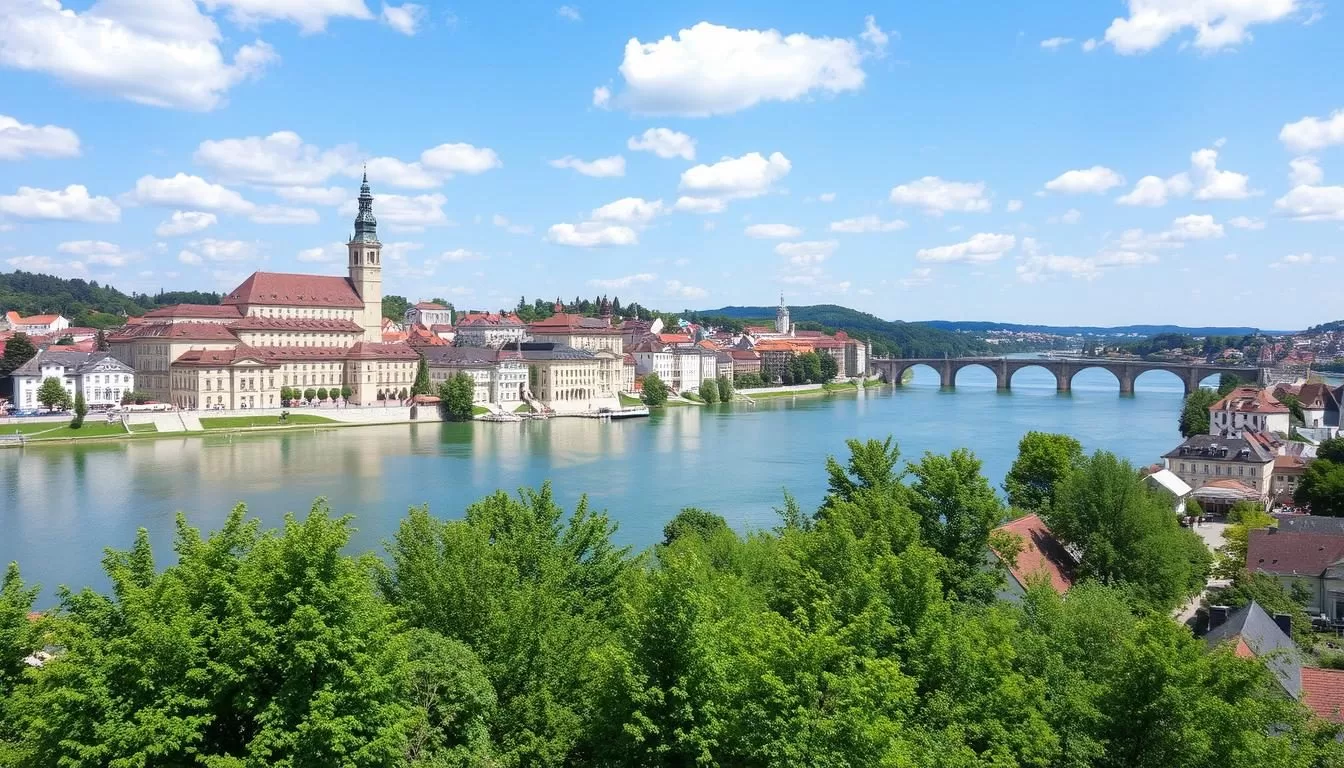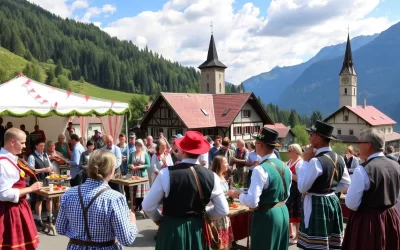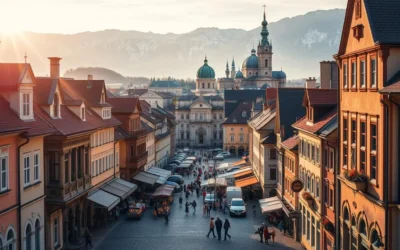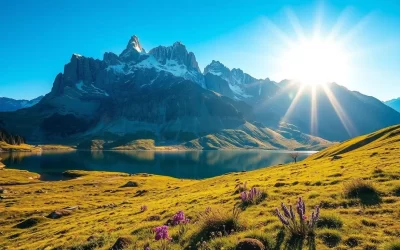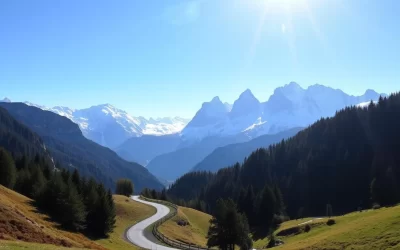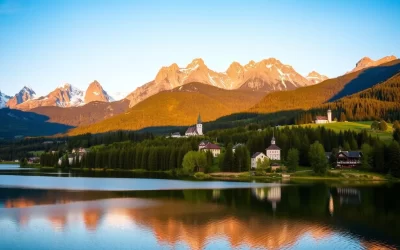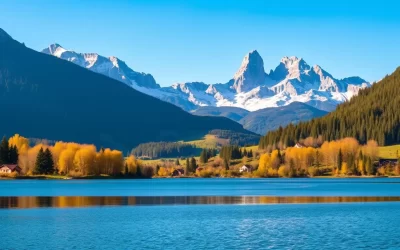✓ Accommodations✓ Flights✓ Rental Cars
Experience the Charm of Krems an der Donau
Nestled on the banks of the Danube River, Krems an der Donau is a charming historic city that offers a unique blend of medieval architecture, wine culture, and scenic beauty. This picturesque city of 25,000 residents feels more like an Austrian village and serves as the gateway to the UNESCO World Heritage Wachau Valley, making it an ideal destination for history buffs, wine enthusiasts, and nature lovers alike.
Krems boasts an incredibly rich history dating back to the Stone Age, with archaeological evidence suggesting that even prehistoric people made use of the region’s abundant grapes. Whether you’re planning a day trip from Vienna or stopping as part of a Danube River cruise, Krems offers a wealth of attractions from its well-preserved medieval old town to world-class museums and renowned wineries.
In this guide, you’ll discover the top things to do in Krems, from exploring ancient city gates and cobblestone streets to sampling the famous Wachau Valley wines and apricot delicacies that have made this region famous. With its unique blend of history, culture, and natural beauty, Krems an der Donau is a must-visit destination in Austria.
Discovering Krems: A Historic Gem on the Danube
Krems, a hidden gem on the Danube River, is waiting to be discovered. As you explore this charming city, you’ll uncover its rich history, cultural significance, and breathtaking natural beauty.
Where is Krems Located?
Krems der Donau is perfectly positioned in Lower Austria, approximately 80 kilometers (50 miles) west of Vienna, making it easily accessible for a day trip from the capital. The city sits at the eastern gateway to the Wachau Valley, a UNESCO World Heritage Site renowned for its picturesque landscape of rolling hills, terraced vineyards, and the winding Danube River.
Why Visit This Wachau Valley Treasure
The city of Krems boasts an extraordinary historical significance, with archaeological discoveries revealing human settlement dating back to the Stone Age. The strategic location at the confluence of the Krems and Danube rivers made this city an important trading center throughout history. You’ll be captivated by the region’s unique microclimate, which creates ideal conditions for growing the Grüner Veltliner and Riesling grapes that have made Wachau Valley wines world-famous.
The city’s well-preserved medieval architecture, combined with its vibrant cultural scene and proximity to natural beauty, makes Krems a must-visit destination that offers a perfect blend of history, culture, and scenic splendor.
Exploring the Medieval Old Town
As you step into Krems’ medieval old town, you’re transported to a bygone era. The historic charm and picturesque streets invite you to explore and discover its many treasures.
Steiner Tor: The Iconic City Gate
The Steiner Tor is a must-see landmark in Krems, representing one of the last remnants of the medieval walls that once surrounded the city. Built in the 15th century and restored after being damaged by Hungarian troops in 1477, this gate is a testament to Krems’ rich history. The clock tower above the portal, renovated in the 18th century, adds to its grandeur.
As you pass through the Steiner Tor, notice the inscription “AEIOU,” which stands for “Alles Erdreich ist Österreich untertan” or “All Earth is Subordinate to Austria,” a bold motto of Emperor Frederick III. The gate also features three historic crests from 1756, including the town crest with a crowned double eagle, a privilege granted to only a few cities, including Vienna.
Landstrasse: The Charming Pedestrian Zone
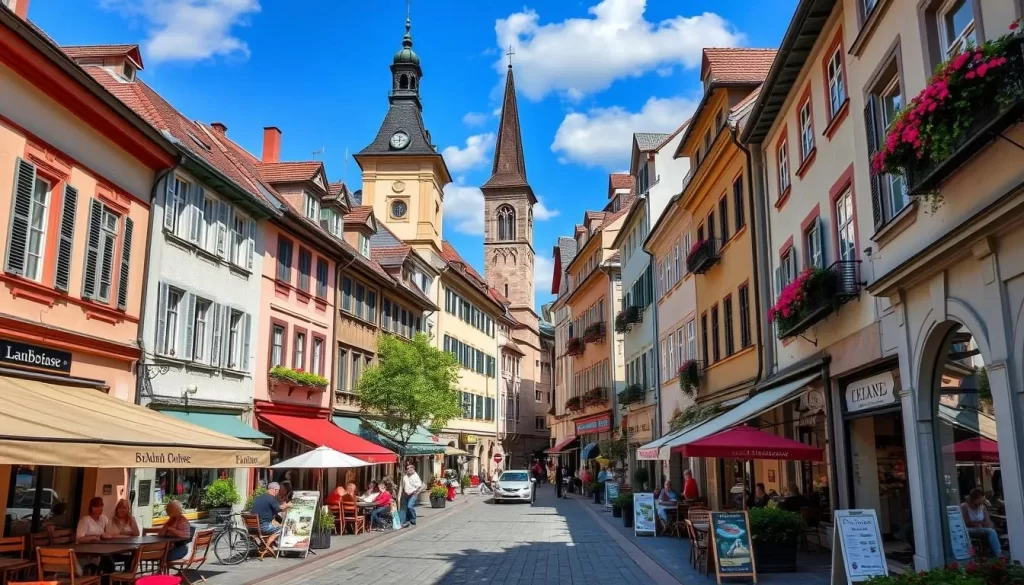
Once you’ve passed through the Steiner Tor, you’ll find yourself on Landstrasse, the heart of Krems’ commercial and social life. This charming pedestrian zone is lined with a variety of shops, cafes, and historic buildings, offering a delightful experience for visitors. You can shop for traditional folk costumes, local specialties like Wachau apricot products, and other unique souvenirs.
The cobblestone streets branching off from Landstrasse are perfect for getting lost in the medieval charm of Krems. Discover hidden courtyards, picturesque corners, and historic buildings that make Krems’ old town a photographer’s paradise. Whether you’re looking to shop, dine, or simply soak in the atmosphere, Landstrasse and its surrounding streets have something for everyone.
Must-Visit Historic Buildings and Churches
Krems’ historic heart is filled with impressive buildings and churches that are a testament to its importance as a trading center in the medieval and Baroque periods. As you explore this charming town, you’ll discover a plethora of architectural gems that showcase its rich cultural heritage.
Pfarrkirche St. Veit (Wachau Cathedral)
The Pfarrkirche St. Veit, also known as the Wachau Cathedral or Dom der Wachau, is a magnificent Baroque church that dates back to the 1600s. Its gilt-adorned interiors and impressive architectural details are truly awe-inspiring. The cathedral’s ornate design exemplifies the Baroque style that flourished in Austria during the 17th century, featuring elaborate altars and stunning ceiling frescoes.
The church houses notable works by the renowned Baroque artist Martin Johann Schmidt, known as Kremser Schmidt. As you admire the cathedral’s grandeur, you’ll gain insight into the religious and artistic heritage of Krems.
The Town Hall and Historic Squares
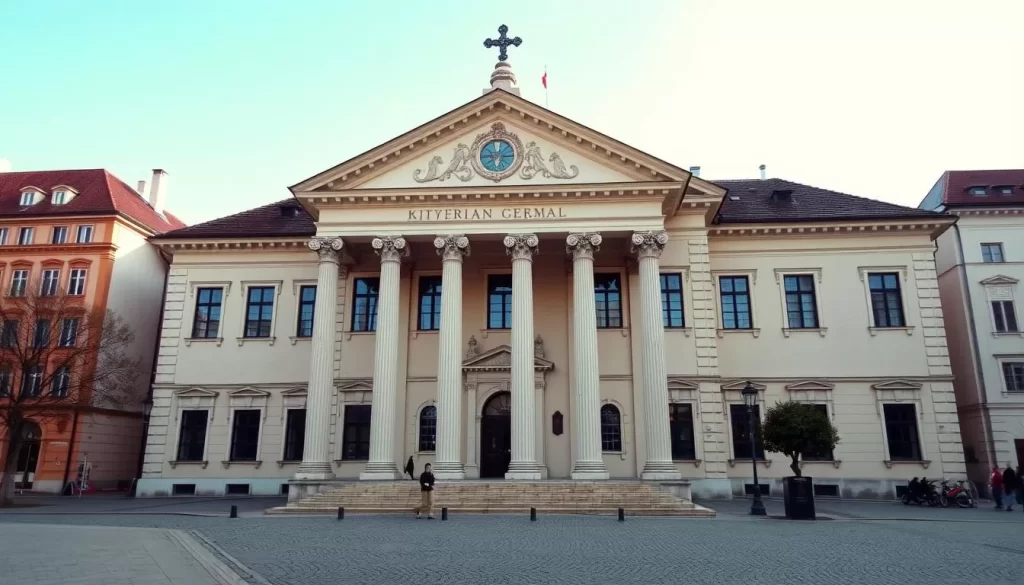
Across from the Pfarrkirche St. Veit stands the impressive Town Hall, or Rathaus, with its columned hall dating back to the 16th century. The Town Hall’s facade contributes significantly to the historic character of the city center, making it a must-visit landmark. As you explore the surrounding historic squares, you’ll get a sense of how civic and religious life intertwined throughout Krems’ long history.
These historic buildings, including the Town Hall and Pfarrkirche St. Veit, represent the wealth and importance Krems held as a trading center during the medieval and Baroque periods. The strategic location of Krems on the Danube made it a significant economic hub, rivaling Vienna in terms of its influence.
Krems, Austria: Best Things to Do for Wine Lovers
Discover the wine treasures of Krems, Austria, a gem in the heart of the Wachau Valley. As you explore this charming town, you’ll find that wine is the lifeblood of the region, with the Kremstal wine region being one of Austria’s oldest and most prestigious viticultural areas.
The Kremstal Wine Region
The Kremstal wine region is renowned for producing exceptional white wines that have gained international acclaim. The region specializes in crisp, mineral-forward Grüner Veltliner and Riesling varieties that benefit from the unique microclimate created by hot eastern winds during the day and cool forest air at night flowing over the terraced vineyards.
The Wachau Valley’s 2,600 hectares of vineyards produce wines with protected designation of origin status, similar to French AOC or Italian DOC classifications, ensuring the authenticity and quality of every bottle.
Top Wineries and Wine Tasting Experiences
A visit to Weingut Stadt Krems, the city’s own winery established in 1452, offers you the opportunity to sample wines for just €1 per taste and take guided tours of their historic cellars. For a more casual wine experience, stop by the Weinhimmel Weinbar on Landstrasse, where you can sample local vintages while people-watching in the heart of the old town.
Wine enthusiasts should time their visit during the harvest season (September to October) when the vineyards are bustling with activity and many wineries host special events and tastings that showcase the region’s viticultural heritage.
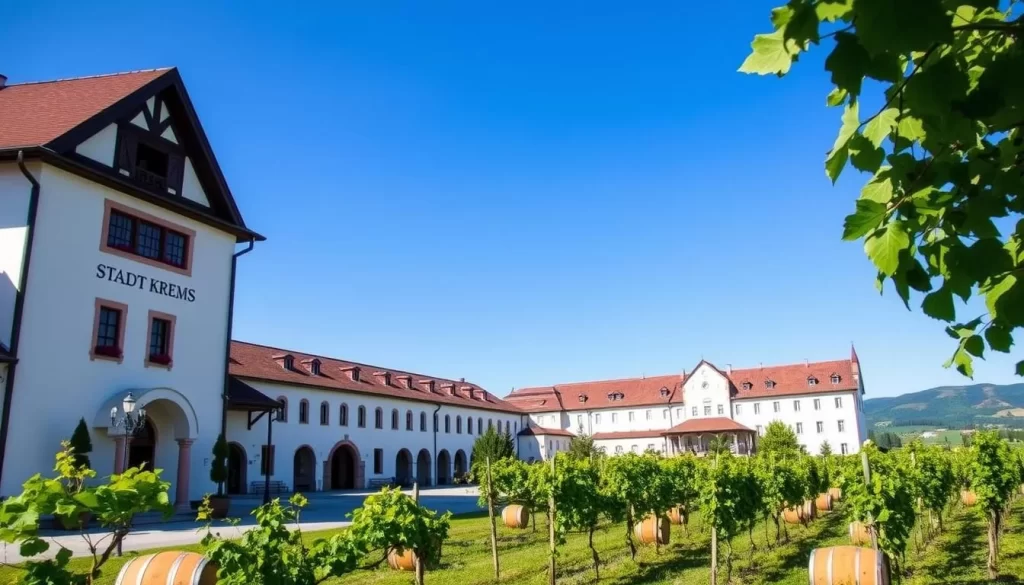
Cultural Attractions and Museums
As you wander through Krems, you’ll discover a city that’s as rich in culture as it is in history. The city’s vibrant cultural scene is a perfect blend of traditional and contemporary attractions.
The Kunstmeile (Art Mile)
The Kunstmeile, or “Art Mile,” is the heart of Krems’ cultural landscape. This vibrant area is home to several world-class institutions, including the Caricature Museum, the Kunsthalle Art Gallery, and the striking modern architecture of the Landesgalerie Niederösterreich (State Gallery of Lower Austria). As you explore the Kunstmeile, you’ll be treated to a diverse range of artistic expressions, from contemporary installations to historical exhibitions.
Museum of Krems and Other Cultural Sites
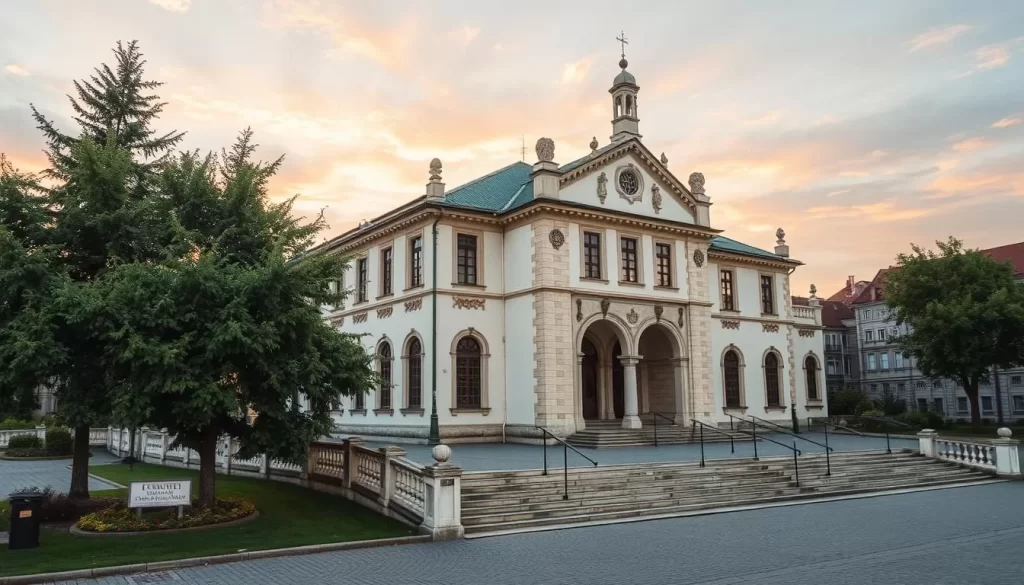
A visit to the Museum of Krems, housed in a former Dominican monastery, offers a deep dive into the city’s rich history. The museum features exhibits on local Baroque artist Martin Johann Schmidt (Kremser Schmidt) and the famous Kremser Mustard. One of the museum’s highlights is a replica of the Venus of Galgenberg, a 30,000-year-old figurine discovered near Krems, representing the oldest piece of art ever found in Austria. The museum, along with other cultural sites in Krems, showcases the city’s ability to blend its medieval heritage with contemporary artistic expression.
As you explore these cultural attractions, you’ll appreciate how Krems seamlessly blends its historical roots with modern cultural flair, creating a dynamic landscape that appeals to visitors of all interests. The museums and galleries often host special exhibitions and events throughout the year, so it’s a good idea to check their schedules when planning your visit to make the most of your time in Krems.
Exploring Stein: Krems’ Twin Town
Discover the charm of Stein, Krems’ twin town, located on the Danube. Stein is a treasure trove of history and culture, waiting to be explored.
Historic Highlights of Stein
Stein is home to numerous historic landmarks. You can wander down Steinlanderstrasse, admiring the well-preserved 16th-century houses that line the streets. The Town Hall Square is another must-visit, with its pastel-colored buildings creating a picturesque scene.
A highlight of Stein is the Pfarrkirche St. Nikolaus, a church that dates back to 1400, showcasing the area’s medieval religious architecture. Art enthusiasts will appreciate the former home of renowned Baroque artist Martin Johann Schmidt (Kremser Schmidt) at Steiner Landstrasse No.122, with its delicate facade preserved as a testament to the region’s artistic heritage.
Connecting Between Krems and Stein
Stein is easily accessible from Krems by walking west from the Steiner Tor along the Art Mile. If you’re arriving on a Danube river cruise, you’ll likely dock at Stein, making it your first point of contact with the area. This convenient connection makes Stein a natural extension of your exploration of Krems der Donau.
As you explore Stein, you’ll find that it’s a charming town that complements Krems perfectly, offering a unique blend of history, culture, and natural beauty along the Danube.
Day Trips from Krems
Krems serves as an excellent starting point for various day trips to nearby historical and cultural sites. The surrounding region is rich in history, wine, and natural beauty, making it an ideal location for exploration.
Gottweig Abbey
Just 9 km south of Krems lies Gottweig Abbey, a 900-year-old Benedictine monastery perched on a hilltop. This historic site offers spectacular views of the surrounding countryside and is home to a beautiful Baroque church, a gift shop, a restaurant, and a museum in the Imperial Apartments.
One of the highlights of visiting Gottweig Abbey is climbing the Imperial Staircase, the largest Baroque staircase in Austria, topped by a stunning ceiling fresco. You can also purchase locally produced apricot wine, a specialty of the abbey, which has been made here since 1083.
Exploring the Wachau Valley
The Wachau Valley is a must-visit destination for anyone traveling to Krems. This picturesque region is known for its terraced vineyards, medieval castles, and charming villages. You can explore the valley by car, bicycle, or boat tour, depending on your preferred pace and style of travel.
A day tour of the Wachau Valley offers numerous hiking trails that lead through vineyards and to castle ruins, providing both exercise and breathtaking views of the Danube River. For wine enthusiasts, the valley’s wineries and wine tastings are a highlight, showcasing the region’s renowned wines.
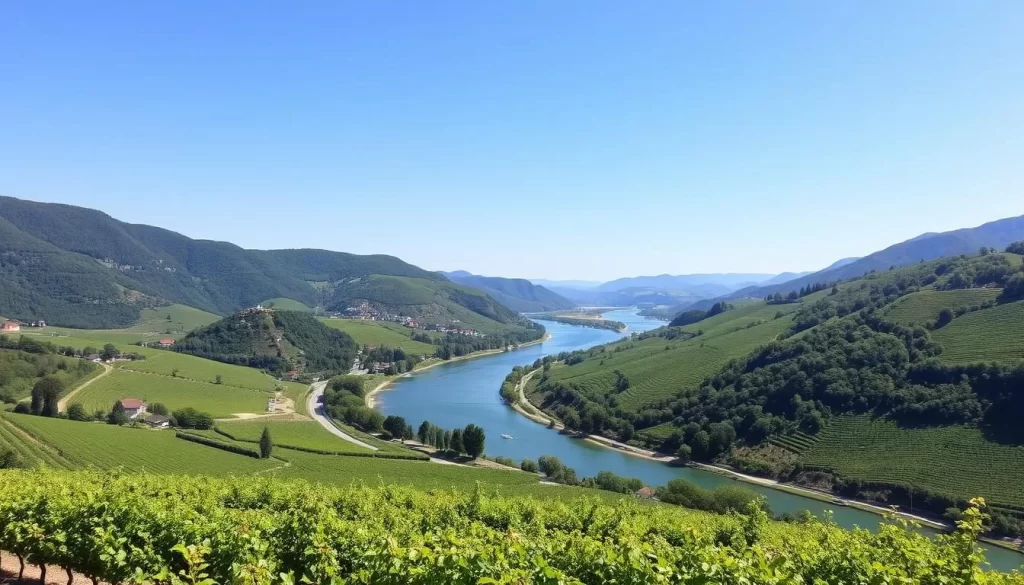
In addition to Gottweig Abbey and the Wachau Valley, another notable day trip destination is Melk Abbey, located about 37 km from Krems. This famous Baroque ensemble features marble halls, spiraling staircases, and a magnificent library housing medieval manuscripts.
Practical Travel Information
Before you embark on your adventure to Krems, here are some practical tips to consider. Krems is a historic gem on the Danube, and with the right information, you can make the most of your visit.
How to Get to Krems
You can easily reach Krems from Vienna by taking a direct train from Wien Franz-Joseph Bahnhof Train Station. The trip takes just over an hour, making it a perfect day trip from the capital. Alternatively, consider taking a boat with DDSG Blue Danube for a more scenic route, although this option is slower than the train.
Where to Stay
When deciding where to stay, you have options ranging from luxurious hotels to centrally located guesthouses. The 4-star Steigenberger Hotel & Spa Krems offers modern amenities and spa facilities, while Gästehaus auf der Kunstmeile on the Art Mile gets great reviews for its location.
When to Visit
The best time to visit Krems is during late spring (April-June) when the apricot trees are in bloom or early fall (September-October) during the wine harvest season. Summer offers perfect weather for exploring outdoor attractions, while winter brings charming Christmas markets.

Conclusion: Making the Most of Your Visit to Krems
As your visit to Krems comes to a close, the memories of its cobblestone streets, historic buildings, and the serene Danube River stay with you. Krems der Donau, with its iconic Steiner Tor gate, offers a perfect blend of history, culture, and natural beauty. Whether you’ve spent your time wandering the cobbled streets of the old town, sampling wines at local vineyards, or exploring cultural attractions, Krems rewards visitors with authentic Austrian experiences.
The city’s connection to the Danube River has shaped its history and character, providing a transportation route and perfect conditions for vineyards. For the best experience, plan to spend at least a day in Krems, and consider staying overnight to enjoy its quiet charm. Whether you’re visiting as a day trip from Vienna or part of a longer Danube journey, Krems will leave you with lasting memories of this Austrian gem.
The above is subject to change.
Check back often to TRAVEL.COM for the latest travel tips and deals.
